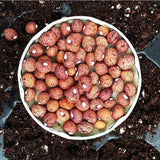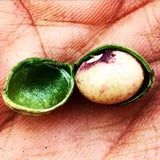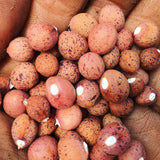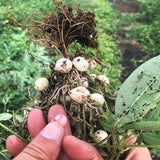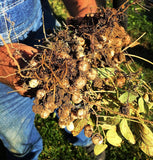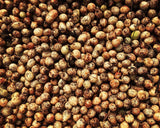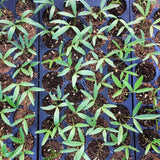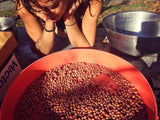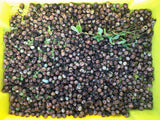Speckled Bambara Groundnuts
Vigna subterranea
Very limited quantities! Please limit two packets per customer so more can enjoy and preserve this legume!
Barbaras are grown by hundreds of thousands of subsistence farmers in semi-arid Africa (where they were first domesticated) as well as in Indonesia, Thailand, and Malaysia. They are the third most important legume on the continent, after their cousin the cowpea (black eyed pea) and the peanut, with whom their history is entwined. Peanuts, originally from Paraguay and Brazil, traveled to Africa via Spain during the transatlantic slave trade, and were readily adopted because the grow and are prepared in the same way. Both plants grow their edible seeds underground from pegs that dive down from fertilized yellow flowers. You can boil or roast the fresh seeds (like peanuts) or dry them to make four, dumplings, cakes, or porridge. According to the BamNetwork (where much of this info came from), many people prefer Bambara milk to soy or cowpea. Bambara is very nutritious, very drought tolerant, and it gives back by fixing atmospheric nitrogen in the soil. My Speckled Bambara seeds came from Roughwood Seed Collection, and theirs came from a market in Francistown, Botswana in 2001.
Also known as bambara beans, jugo beans, ditloo marapo, indlubu, hlanga, njugo, nduhu, phonda, and tindhluwa.
Seeds per pack: 16
Planting / harvesting notes
Sow seeds 1" deep indoors 3-4 weeks before planting. Transplant one month after last frost - these babies love heat! Space plants by 8-10". When the tiny yellow flowers are pollinated, they will form "pegs" that dig under the soil and create your bambara fruits. Harvest when soil is dry and evening temperatures dip below 40 degrees fahrenheit. Some bambara fruits may fall off the plants and remain in the soil during harvest. Do a second check with a fork or rake to find any you left behind. Let the plants dry in the sun for a few days before removing peanuts. Allow bambaras to cure for up to a week before storing.
Seed keeping notes
Allow bambara fruits to dry in their shell in a well-ventilated place. Shell the seeds, and allow them to lay flat on a paper towel in a single layer away from direct sunlight, and with some air flow to help with drying.










